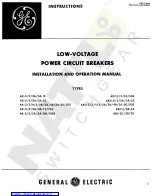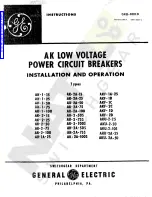
17
Instruction Book
IB182917EN September 2018 www.eaton.com
DHP-VR
+
VR-Series
+
Replacement Circuit Breaker
Figure 4.10.d shows the circuit breaker in the closed state after the
closing springs have been recharged. The recharging of the spring
rotates the closing cam one half turn. In this position the main link
roller rides on the cylindrical portion of the cam, and the main link
does not move out of position.
4.3.3 TRIPPING OPERATION
When the trip bar “D” shaft (Figure 4.10.b, Item 9) is turned by
movement of the shunt trip clapper (11), the trip latch will slip past
the straight cut portion of the trip bar shaft and will allow the banana
link and main link roller to lower. The energy of the opening spring
and contact loading springs is released to open the main contacts.
The mechanism is in the state illustrated (Figure 4.10.b) after the
circuit breaker is tripped open.
4.3.4 TRIP-FREE OPERATION
When the manual trip button is held depressed, any attempt to close
the circuit breaker results in the closing springs discharging without
movement of the pole shaft or vacuum interrupter stem.
4.4 CONTROL SCHEMES
There are two basic control schemes for the VR-Series
+
circuit
breaker elements, one for dc control and one for ac control voltages
(Figure 4.4). Specific customer order wiring schematics and
diagrams are included with each circuit breaker.
There may be different control voltages or more than one tripping
device, but the principal mode of operation is as follows:
As soon as the control power is applied, the spring charging motor
automatically starts charging the closing spring. When the springs
are charged, the motor cut off LS1/bb switch turns the motor off.
The circuit breaker may be closed by closing the control switch close
(CS/C) contact. Automatically upon closing of the circuit breaker, the
motor starts charging the closing springs. The circuit breaker may be
tripped any time by closing the control switch (CS/T) contacts.
Note the position switch (PS1) contact in the spring release circuit
in the scheme. This contact remains closed while the circuit breaker
is being racked between the ‘Test’ and ‘Connect’ positions for
VR-Series
+
circuit breakers. Consequently, it prevents the circuit
breaker from closing automatically, even though the control close
contact may have been closed while the circuit breaker is racked to
the ‘Connect’ position.
When the CS/C contact is closed, the SR closes the circuit breaker.
If the CS/C contact is maintained after the circuit breaker closes, the
Y relay is picked up. The Y/a contact seals in Y until CS/C is opened.
The Y/b contact opens the SR circuit, so that even though the circuit
breaker would subsequently open, it could not be reclosed before
CS/C was released and remade. This is the anti-pump function.
4.4.1 TIMING
The opening and closing times for the circuit breakers vary
depending upon the control voltage, power rating, environment and
test equipment. Differences in timing are expected between initial
factory measurements and field inspections. Circuit breaker timing
can be measured by service personnel using available equipment
before installation and in conjunction with regular maintenance
periods to assist in tracking the general health of the circuit breaker.
Typical ranges as observed using nominal control voltages are listed
in Table 4.
Tablt 4. Timt Ptr Evtnt
Event
Milliseconds
Closing Time
(From Initiation of Close Signal to Contact Make)
45 - 60
Opening Time
(Initiation of Trip Signal to Contact Break)
30 - 38
Reclosing Time
(Initiation of Trip Signal to Contact Make)
140 - 165
otte:
N
Valuts art typical at nominal rattd control voltagt(s).
4.5 SECONDARY DISCONNECT CONTACT BLOCK
The circuit breaker control wiring is arranged for draw-out
disconnecting by means of a 15 point male plug arranged to connect
to a female receptacle mounted in the rear of the existing DHP
circuit breaker compartment. The secondary disconnect contact
block is mounted on a movable bracket on the left side of the circuit
breaker truck (Figures 4.3). This permits it to be extended to the
rear while the circuit breaker is in the ‘Test’ position to connect with
the stationary receptacle in the circuit breaker compartment so that
the control circuits are completed. Control wiring terminates first at
terminal block(s) mounted on the circuit breaker truck, and continues
from the terminal blocks to the male contact plug.
Normally the secondary disconnect contact is held stationary relative
to the circuit breaker chassis. This is accomplished by a hinged joint
in the hand operating rod which acts on the edge of the lower front
truck panel to hold the assembly in position.
To engage the secondary disconnect contact while the circuit
breaker is in the ‘Test’ position, lift the handle on the front left hand
side of the circuit breaker chassis to a horizontal position. Once the
rod is pointing straight out from the circuit breaker, push it manually
to the rear until the secondaries are initially engaged. At this point,
the small horizontal pin in the handle will have engaged two slots in
the lever, which is pivoted immediately above the handle. To insure
complete secondary engagement, push down firmly on the curved
end of the lever as far as it will go, using a foot or hand (Figure 5.7).
When using a foot, care should be taken not to bend the lever by
using excessive force.
Figurt 4.3. Stcondary Disconntct Contact Block
(Exttndtd Position)
















































